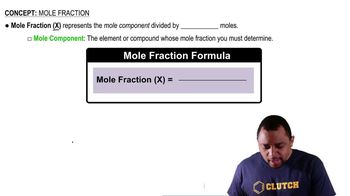Here are the essential concepts you must grasp in order to answer the question correctly.
Vapor Pressure
Vapor pressure is the pressure exerted by a vapor in equilibrium with its liquid or solid phase at a given temperature. It reflects the tendency of particles to escape from the liquid phase into the vapor phase. In this context, the vapor pressures of heptane and octane indicate how readily each component evaporates, which is crucial for determining their contributions to the total vapor pressure of the mixture.
Recommended video:
Raoult's Law and Vapor Pressure
Raoult's Law
Raoult's Law states that the vapor pressure of a solvent in a solution is directly proportional to the mole fraction of the solvent in the mixture. For a mixture of heptane and octane, this law allows us to calculate the total vapor pressure based on the individual vapor pressures and their respective mole fractions. This principle is essential for solving the problem of finding the mole fraction of heptane in the given mixture.
Recommended video:
Raoult's Law and Vapor Pressure
Mole Fraction
Mole fraction is a way of expressing the concentration of a component in a mixture, defined as the ratio of the number of moles of that component to the total number of moles of all components in the mixture. In this question, calculating the mole fraction of heptane involves using the total vapor pressure and the individual vapor pressures of heptane and octane, which is key to understanding the composition of the gasoline mixture.
Recommended video:



